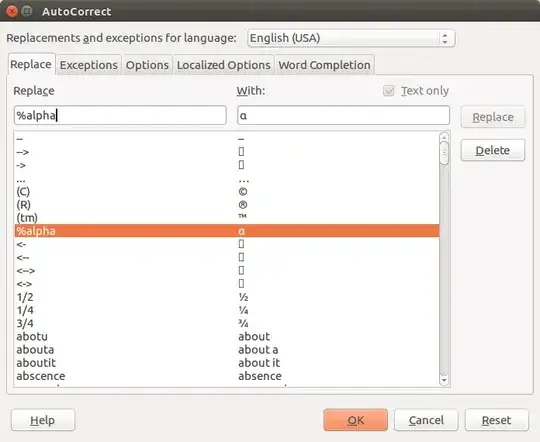I am preparing a presentation on some physics concept for which I need to write e.g. phi, phi dagger, and Hamiltoninan symbol. Is there a way to do it with LibreOffice impress?
-
2Libre office? Physics? Better to start using LaTeX IMHO. – ddmytrenko Oct 19 '15 at 20:11
-
1using since an year, i posted that as an undergrad, long time ago ;) – kernel_panic Oct 20 '15 at 03:19
11 Answers
I know Libreoffice Math has a symbol catalog (I believe Libreoffice writer does too) but if copying from those does not work.
Try Ctrl+Shift+U, let go of u but not Shift+Ctrl and type 03A6 (Greek capital letter phi)
The code is ASCII, you can search for what you need here: http://ascii-table.com/unicode-search.php
-
-
-
+1 for the link, and in addition you can just copy/paste character from the cited website. – gaborous Mar 21 '15 at 18:35
-
-
Add a formula object via main menu → Insert → Object → Formula….
%letter seems to work most simply. For example, I wanted Lambda, so %lambda %delta %theta gives the lower case letters, and %ALPHA or %CHI for their capital versions.
- 36,264
- 56
- 94
- 147
-
1Can you elaborate? In Libreoffice Impress, typing in a textbox
%lambdaand pressing enter does not give meλ. – Garrett Jan 06 '15 at 21:38 -
1This works for me in LibreOffice Writer's formula mode. Access the formula mode from Insert > Object > Formula... This was just the answer I was looking for! Thanks @Andrew. – snake_charmer Mar 18 '16 at 16:04
In Impress menu: Insert > Object > Math. Impress window should now look like Math window. Go to Tools > Catalog and fiddle with symbols. When you're done with Math input menus just click on the background of your slide.
You can also use Insert > Special character but I think it lacks many basic symbols when compared to the method involving Math.
LibreOffice components are integrated. Learn how to use it to your advantage ;)
- 4,044
-
This is good if you don't know the name, if you know the name do the same but instead of going to the catalog you can do as @andrew-quesenberry answer and write it directly preceded by a %. – PhoneixS Jun 18 '14 at 11:44
-
It's an old post but I think it might still be relevant. There's another simple way to achieve this by making use of the otherwise annoying autocorrect option. Here's how you can do that:

- 413
If you want to include greek text inline with regular text, an easy way to do so is just change the font to "Symbol" for those characters that you want to be greek. Then type the case-specific letter corresponding to the greek letter (e.g. P for Pi, n for nu, L for Lambda).
- 31
- 1
The best solution is to use latex beamer - which works very well in Ubuntu.
LibreOffice impress has severe limitations with formulas - you cannot insert them inline with other text. It doesn't appear they are in any hurry to fix this.
If you insist on using impress, one workaround is to use the TexMaths equations plugin. This allows you to insert latex code into a slide. You can insert display equations. In-line equations in impress do not appear to work (but works in writer). The workaround is to create the entire slide (maybe minus the title) using TexMaths and choosing "latex" (rather than display or inline). For example, insert the following in the TextMaths code box:
This is a list:
\begin{itemize}
\item This is the first item
\item This is the second item
\item Here is an inline equation: $X_i=\alpha_i + \beta_i \mu + \epsilon_i$
\end{itemize}
More text can follow.
This will create a slide with text, an itemized list, and an in-line equation. You can insert the title in the regular impress slide's title text box. You can edit the TexMaths code later if necessary.
But - IMO - latex is superior to any other method for creating documents or presentations.
- 103
- 11
- 1
Use Insert → Special Characters.
- 117,780
- 435
-
This answer is a duplicate of this existing answer: https://askubuntu.com/questions/110909/type-greek-letters-as-well-as-physics-symbols-in-libreoffice-impress/110923#110923 – karel Jul 15 '19 at 16:21
In the special cahracters, I click "Font" and select "Open Symbol". It provides a list of greek symbol, pi, math approximate symbol, alpha, etc.
- 121
You can also do a merge of Andrew and Bucic answers if you know the name of the letter (for example delta) and you are in Writer. What you must do is:
- Write your text/formula and instead of the symbol use the name preceded by a %. For example:
Hello this %DELTA is the uppercase delta symbol. - Select the symbol/formula.
- Go to menu
Insert-->Object-->Formula... - You get it converted to the symbol!
- 642
You can also do alt+i -> p.
Then you change the upper option to "greek extended" (or "basic greek") and find the letter..
After the first time, the pointer will already be on the last letter you chose - in the greek-letters area
- 261